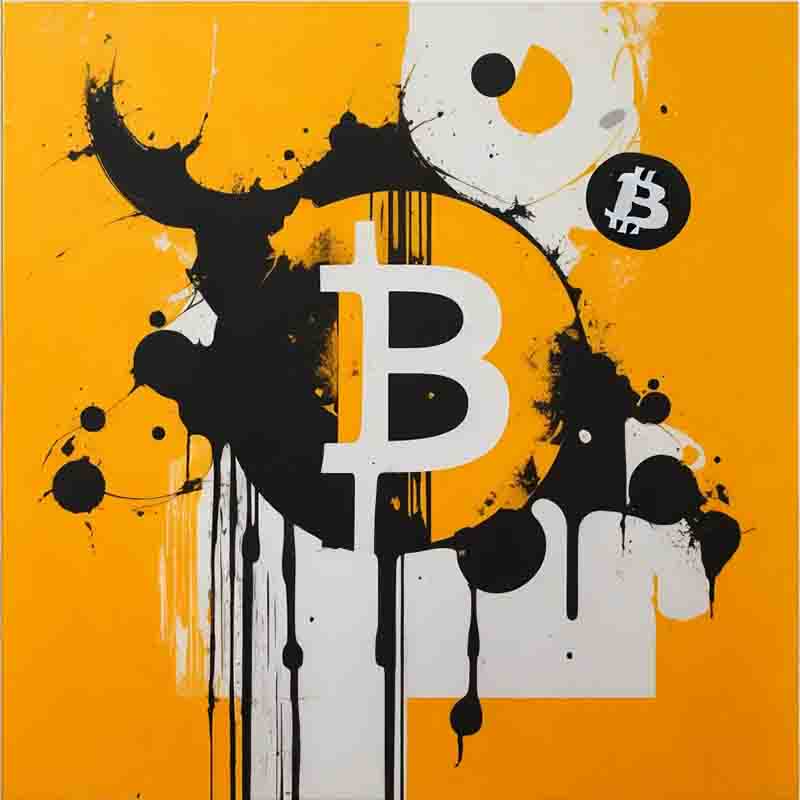Current Bitcoin Price:
(Source: CoinGecko)
Demystifying Bitcoin: The World's Leading Cryptocurrency
Bitcoin is a digital currency that operates on a decentralized network of computers. It allows for peer-to-peer transactions without the need for intermediaries like banks. Understanding the fundamentals of how Bitcoin works is crucial for anyone looking to get involved in cryptocurrency.

Using Bitcoin is no longer reserved for the tech-savvy elite. Obtaining Bitcoin is as simple as setting up a digital wallet and using exchanges. It offers a versatile range of uses, from online shopping to international remittances.
The Role of Bitcoin
Bitcoin, often referred to as digital gold, has evolved from its origins as a mysterious invention to become a transformative player in the world of finance and technology.
At its core, Bitcoin is a decentralized digital crypto currency that operates on a peer-to-peer network, free from the control of central banks and governments.
Bitcoin itself is not files or data stored on one's computer's hard drive, like MP3s or PDFs.
"Owning Bitcoins" refers to owning a Bitcoin address with its balance recorded and tracked in the blockchain.
The ownership of a Bitcoin address implies the control of the associated private key, which enables the signing of transactions.
Bitcoin's journey from obscurity to recognition by a broader audience has been characterized by significant milestones and has left a profound footprint on the financial landscape.
Bitcoin's ascent from a whitepaper to a global financial force is nothing short of remarkable. It stands as a testament to the power of decentralized networks and the potential for innovation in finance.
The History of Bitcoin
The genesis of Bitcoin can be traced back to a Bitcoin whitepaper published in 2008 by an entity known as Satoshi Nakamoto.
This groundbreaking document introduced the concept of a peer-to-peer electronic cash system, where transactions would be recorded on a transparent and immutable ledger called the blockchain.
Unlike traditional currencies, Bitcoin's supply is limited to 21 million coins, a feature that has drawn comparisons to precious metals like gold and ignited debates about its potential as a store of value.
One of the defining features of Bitcoin is its security, ensured through cryptographic techniques.
Each user possesses a public key, serving as their Bitcoin address, and a private key, which must be kept secret.
Transactions are signed with the private key, proving ownership and authenticity.
This robust security has made Bitcoin resistant to fraud and hacking, setting it apart from conventional financial systems.
Bitcoin's journey has been punctuated by price volatility, attracting speculators and investors seeking to capitalize on its price swings.
Bitcoin halving is a fundamental aspect of the Bitcoin protocol that occurs approximately every four years or after every 210,000 blocks are mined.
Bitcoin: Digital Gold Rush

The meteoric rise of Bitcoin has made it a captivating investment asset. Investors, both individual and institutional, have flocked to it as a means of preserving wealth and seeking impressive returns.
While these price movements have sparked both excitement and skepticism, many view Bitcoin as a hedge against inflation and economic uncertainty, a digital asset that can retain its value over time.
The acceptance of Bitcoin goes far beyond the circle of early adopters and technology enthusiasts.
Bitcoin's rise has not been without its challenges. Scalability issues, environmental concerns related to energy-intensive mining, and a patchwork of global regulatory approaches have cast a spotlight on the cryptocurrency's hurdles.
The regulatory landscape for Bitcoin varies from country to country, with some embracing it as a legitimate asset class and others imposing restrictions.
Bitcoin's potential impact on finance, technology, and the global economy will continue to evolve.
The story of Bitcoin is one of financial empowerment, decentralization, and the limitless possibilities of blockchain technology - a story that will continue to dazzle the world.
Bitcoin stands as a symbol of financial sovereignty, innovation, and the decentralization revolution.
Its journey from obscurity to mainstream recognition is a testament to the power of decentralized networks and the transformative potential of blockchain technology.
Peering into the Bitcoin Mechanism
Bitcoin operates on the revolutionary blockchain technology, a transparent and immutable ledger.
Transactions are recorded in blocks, forming an unbroken chain.
Each participant in the network maintains a copy of this ledger, ensuring transparency, security, and censorship resistance.
Bitcoin as a Digital Asset

The world of Bitcoin is dynamic and continually evolving. Staying informed is essential to make the most of your Bitcoin experience.
Unlike traditional currencies, Bitcoin has a capped supply of 21 million coins, making it an intriguing store of value.
Its scarcity and decentralized nature have led many to compare it to precious metals like gold, sparking discussions about its potential to serve as a hedge against economic turmoil.
Bitcoin Glossary
Whether you're a novice or a seasoned crypto enthusiast, there's something for everyone in the journey through the world of Bitcoin.
-
Bitcoin (BTC): The original and most well-known cryptocurrency, created by an anonymous entity or individual known as Satoshi Nakamoto. Bitcoin operates on a decentralized network and is often referred to as digital gold.
-
Blockchain: A decentralized and transparent ledger that records all Bitcoin transactions. It consists of a chain of blocks, each containing a set of transactions.
-
Cryptocurrency: Digital or virtual currencies that use cryptography for security. Bitcoin is the first and most famous cryptocurrency, but thousands of others exist, known as altcoins.
-
Satoshi: The smallest unit of Bitcoin, named after its creator, Satoshi Nakamoto. One Bitcoin is equivalent to 100 million Satoshis.
-
Wallet: A digital or physical tool used to store, send, and receive Bitcoin. Common types include software wallets (online, mobile, desktop), hardware wallets (physical devices), and paper wallets (physical documents with private keys).
-
Private Key: A secret cryptographic key known only to the owner, used to sign Bitcoin transactions and prove ownership.
-
Public Key: A cryptographic key associated with a Bitcoin address, used for receiving Bitcoin. It is derived from the private key but can be shared openly.
-
Address: A unique string of characters representing the destination of a Bitcoin transaction. It is derived from the public key.
-
Mining: The process of validating and adding new transactions to the Bitcoin blockchain using powerful computers and solving complex mathematical puzzles. Miners are rewarded with newly created Bitcoins and transaction fees.
-
Halving: A programmed event that reduces the rate at which new Bitcoins are created, occurring approximately every four years. It helps control inflation and affects Bitcoin's supply.
-
Fork: A split in the Bitcoin blockchain resulting in two separate chains with different rules. Forks can be contentious (hard forks) or non-contentious (soft forks).
-
Cryptographic Hash: A fixed-length string of characters generated from data (e.g., a Bitcoin block) using a cryptographic algorithm. Hashes are used for security and verification.
-
Confirmation: The process by which a Bitcoin transaction is verified and added to the blockchain. Multiple confirmations increase the security of a transaction.
-
Altcoin: Any cryptocurrency other than Bitcoin. Examples include Ethereum (ETH), Ripple (XRP), and Litecoin (LTC).
-
Exchange: An online platform where users can buy, sell, and trade cryptocurrencies. Popular exchanges include Coinbase, Binance, and Kraken.
-
Wallet Seed: A series of random words used to back up and restore a cryptocurrency wallet. It's crucial for recovering a wallet if it is lost or compromised.
-
Node: A computer connected to the Bitcoin network that stores a copy of the blockchain and helps validate transactions. Full nodes play a crucial role in network security.
-
Mining Pool: A group of miners who combine their computational power to increase the chances of solving blocks and receiving rewards.
-
Double Spending: Attempting to spend the same Bitcoin more than once, which is prevented by the blockchain's consensus mechanism.
-
Smart Contracts: Self-executing contracts with the terms of the agreement directly written into code. Ethereum is a well-known blockchain that enables smart contracts.
The Likewolf Bitcoin glossary provides essential definitions for readers to navigate the cryptocurrency landscape.
As the world of Bitcoin and cryptocurrencies evolves, understanding these terms becomes increasingly important for those looking to engage with this innovative technology.
Using Bitcoin: Getting Started with Bitcoin
To use Bitcoin, you'll need a digital wallet, which can be software-based (online, mobile, desktop) or hardware-based (physical devices).
Once you have a wallet, you can acquire Bitcoin through cryptocurrency exchanges, peer-to-peer platforms, or Bitcoin ATMs.
How Does Bitcoin Work?
Many investors view Bitcoin as a digital store of value, akin to gold. Its limited supply, fungibility, and ability to retain value over time make it an attractive asset for hedging against inflation and economic uncertainty.
Bitcoin transactions involve sending funds from one user's digital wallet to another.
These transactions are verified and added to the blockchain by a network of miners who solve complex mathematical puzzles.
Miners are rewarded with newly created Bitcoins and transaction fees for their efforts.
Bitcoin as an Investment
Bitcoin's meteoric rise to prominence has made it a sought-after investment asset.
Many investors view it as a digital equivalent of gold, a store of value that can potentially hedge against inflation and economic uncertainty.
However, Bitcoin's price volatility requires careful consideration and risk management.
Making Bitcoin Transactions
Bitcoin transactions are straightforward. You need the recipient's Bitcoin address to send funds.
Many online and physical businesses accept Bitcoin as payment, making it a versatile option for purchases.
Additionally, Bitcoin can be used for international remittances, providing a cost-effective way to send money across borders.
Bitcoin: Benefits and Considerations
Using Bitcoin offers benefits such as security, lower transaction fees, and financial inclusion for the unbanked.
However, it's important to be aware of price volatility, regulatory environments, and tax implications associated with Bitcoin transactions.
Securing Your Bitcoin

Bitcoin represents not just a digital currency but a symbol of financial sovereignty, a catalyst for innovation, and a testament to the power of decentralized networks.
Security is paramount in the world of Bitcoin. Users can secure their Bitcoin holdings by using hardware wallets, setting strong passwords, enabling two-factor authentication (2FA), and safeguarding private keys through backups.
Best practices for Bitcoin ownership include staying informed about developments in the cryptocurrency space, avoiding public Wi-Fi for transactions, diversifying investments, understanding tax implications, and using reputable services.
We invite you to understand, question, learn and reflect on the fundamentals of Bitcoin.
The digital gold rush continues.
We are witnessing a financial revolution that knows no boundaries, challenges the status quo, and promises a future where the power of money is firmly in the hands of individuals.
Bitcoin and Symbology Related Fields
The publication date of the Bitcoin Whitepaper, October 31, 2008, coincides with the date of the Celtic festival of Samhain, which is associated with the modern celebration of Halloween.
While the release of the Bitcoin whitepaper was not inherently tied to Celtic culture, it inadvertently parallels the idea of a significant transition and boundary-crossing event.
The connection between Bitcoin and the Celtic festival of Samhain may be an intriguing coincidence, but it can be interpreted as symbolizing the disruptive nature of Bitcoin within the financial world.
Bitcoin: FAQ
Are you curious about music, art, technology, fashion, lifestyle, and beer?
If so, then you need to subscribe to the free Likewolf newsletter.
100% privacy. When you sign up, we'll keep you posted.
Blockchain Insights Await
Explore the Infinite World of Blockchain
